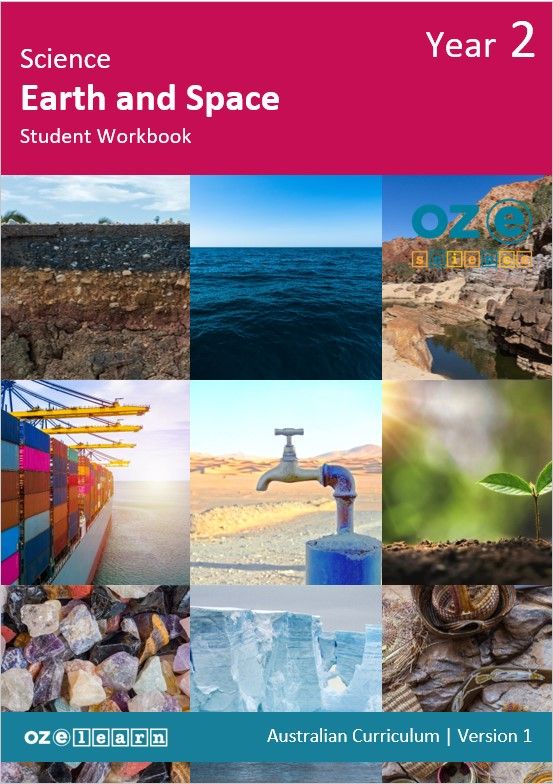Oz-e-science

In Lessons 1 to 9, students learn about:
- the Earth and what it is made of and comparing the water and land covering the Earth’s surface
- water on Earth and making a model showing how water is used as a resource
- what soil is like in the school garden, how soil forms, and how it is used by humans
- important minerals on Earth and the periodic table and comparing their properties
- the ways we move resources in the world and building a model ship to transport resources
- what might happen if a resource runs out and a comparison of food resources in Australia to another country
- the ways Indigenous Australians use natural resources and weaving using reeds
- ways to conserve water resources in their community
- planning and reporting an awareness campaign to conserve water resources in their community.
- Describe the Earth and what it is made of.
- Compare total water to total land on the surface of the Earth.
- Identify examples of water on Earth.
- Make a model to show how water is used by humans as a resource.
- Describe different soil types by what they look, feel, and smell like and what is growing in them.
- Explain what makes soil and how it is used by humans.
- Identify mineral resources that humans use.
- Identify minerals on the periodic table.
- Compare the properties of minerals in everyday products.
- Describe the ways resources are moved around the planet.
- Make a model cargo ship.
- Explain what might happen if a resource runs out.
- Compare the food resources of different people.
- Identify the ways Indigenous Australians use local resources.
- Investigate the use of reeds to weave useful items.
- Observe the ways water is used in a house and school.
- Identify the ways water can be saved more or used less.
- Plan a poster to communicate water conservation.
- Report ideas about water conservation using a poster.
Progress Tests
Progress tests are conducted after every second lesson, allowing teachers to monitor student understanding of the concepts taught over the past two lessons and to identify where reteaching is needed. The Teaching Guide contains the testing questions, and the Student Workbook has a section where students write their answers and score themselves.
Structured Research Activity
The Structured Research Activity (SRA) for this unit is: Students create and present a poster to convey a message about water conservation. The SRA takes place over two lessons so students can apply the Science Understanding and Science Inquiry Skills covered in the unit. Teachers use the Guide to Making Judgements, which is included in the Teaching Guide, to mark the SRA.
End-of-Unit Assessment
The last lesson is the end-of-unit assessment, which has a variety of question formats (e.g. label the diagram, circle the correct answer) to assess student mastery of content from the unit. The end-of-unit assessment is in the Teaching Guide. Teachers copy the assessment and distribute to students at testing time.
Progress tests are conducted after every second lesson, allowing teachers to monitor student understanding of the concepts taught over the past two lessons and to identify where reteaching is needed. The Teaching Guide contains the testing questions, and the Student Workbook has a section where students write their answers and score themselves.
Structured Research Activity
The Structured Research Activity (SRA) for this unit is: Students create and present a poster to convey a message about water conservation. The SRA takes place over two lessons so students can apply the Science Understanding and Science Inquiry Skills covered in the unit. Teachers use the Guide to Making Judgements, which is included in the Teaching Guide, to mark the SRA.
End-of-Unit Assessment
The last lesson is the end-of-unit assessment, which has a variety of question formats (e.g. label the diagram, circle the correct answer) to assess student mastery of content from the unit. The end-of-unit assessment is in the Teaching Guide. Teachers copy the assessment and distribute to students at testing time.

